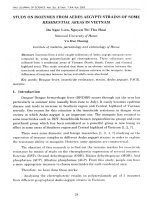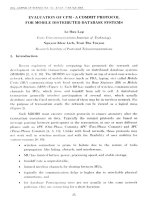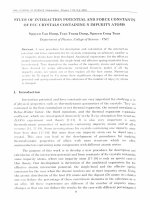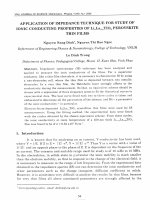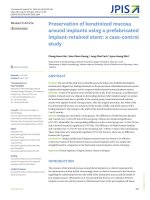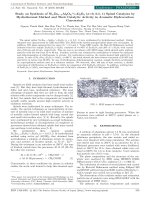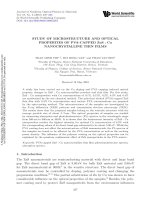DSpace at VNU: Study of Nanostructured Polymeric Composites Used for Organic Light Emitting Diodes and Organic Solar Cells
Bạn đang xem bản rút gọn của tài liệu. Xem và tải ngay bản đầy đủ của tài liệu tại đây (1.69 MB, 6 trang )
Hindawi Publishing Corporation
Journal of Nanomaterials
Volume 2012, Article ID 190290, 6 pages
doi:10.1155/2012/190290
Research Article
Study of Nanostructured Polymeric Composites Used for Organic
Light Emitting Diodes and Organic Solar Cells
Nguyen Nang Dinh,1 Do Ngoc Chung,1 Tran Thi Thao,1 and David Hui2
1 University
of Engineering and Technology, Vietnam National University, 144 Xuan Thuy, Cau Giay, Hanoi 10000, Vietnam
of Mechanical Engineering, The University of New Orleans, New Orleans, LA 70148, USA
2 Department
Correspondence should be addressed to Nguyen Nang Dinh,
Received 17 July 2012; Accepted 10 September 2012
Academic Editor: Marinella Striccoli
Copyright © 2012 Nguyen Nang Dinh et al. This is an open access article distributed under the Creative Commons Attribution
License, which permits unrestricted use, distribution, and reproduction in any medium, provided the original work is properly
cited.
Polymeric nanocomposite films from PEDOT and MEH-PPV embedded with surface modified TiO2 nanoparticles for the hole
transport layer and emission layer were prepared, respectively, for organic emitting diodes (OLEDs). The composite of MEHPPV+nc-TiO2 was used for organic solar cells (OSCs). The characterization of these nanocomposites and devices showed that
electrical (I-V characteristics) and spectroscopic (photoluminescent) properties of conjugate polymers were enhanced by the
incorporation of nc-TiO2 in the polymers. The organic light emitting diodes made from the nanocomposite films would exhibit
a larger photonic efficiency and a longer lasting life. For the organic solar cells made from MEH-PPV+nc-TiO2 composite, a
fill factor reached a value of about 0.34. Under illumination by light with a power density of 50 mW/cm2 , the photoelectrical
conversion efficiency was about 0.15% corresponding to an open circuit voltage Voc = 0.126 V and a shortcut circuit current
density Jsc = 1.18 mA/cm2 .
1. Introduction
Over two recent decades, conducting polymers and polymerbased devices have been increasingly studied, because of
their potential application in optoelectronics as organic light
emitting diodes (OLEDs), field emission transistors (FETs),
solar flexible cells, and so forth [1]. From the point of
energy bandgap, semiconducting polymers also have a gap
(between the highest occupied molecular orbital-HOMOand the lowest unoccupied molecular orbital-LUMO-).
When sufficient energy is applied to a conducting polymer,
it becomes conducting by exciting the electrons from the
HOMO level into the LUMO level. This excitation process
leaves holes in the valence band, and thus creates “electronhole-pairs” (EHPs). When these EHPs are in intimate contact
(i.e., the electrons and holes have not dissociated) they are
termed “excitons.” In presence of an external electric field,
the electron and the hole will migrate (in opposite directions)
in the conduction and valence bands, respectively (Figure 1).
On the other hand, inorganic semiconductors when
reduced to the nanometer regime, possess characteristics
between the classic bulk and molecular descriptions, exhibiting properties of quantum confinement. These materials are
referred as nanoparticles (or nanocrystals). Thus, adding
metallic, semiconducting, and dielectric nanocrystals into
polymer matrices enhances the efficiency and service duration of these devices. The inorganic additives usually have
nanoparticle form. Inorganic nanoparticles can substantially influence the mechanical [2–4], electrical, and optical
(including nonlinear optical as well as photoluminescent,
electroluminescent, and photoconductive) properties of the
polymer in which they are embedded [5–8]. The influence
of nanocrystalline oxides on the properties of conducting
polymers has been investigated by many scientific groups [9–
11]. Many publications have been focused on nanostructured
composites, nanohybrid layers, and heterojunctions, which
can be utilized for different practical purposes. Among these
applications, one can divide two objectives; one focused on
the interaction between electrons and photons in devices
such as OLEDs, where the electricity generates light and the
other aiming and the generation of electricity as in organic
solar cells (OSCs).
2
Journal of Nanomaterials
hA
LUMO
LUMO
HOMO
HOMO
Eg
Figure 1: Formation of “electron-hole pair” induced by an
excitation from an external energy source.
dimensions of 2 mm × 2 mm or 4 mm2 in area. The process
for preparing OSCs was carried-out similarly. However, in
the OSC, a RF-sputtered TiO2 thin layer was added between
the ITO substrate and MEH-PPV+nc-TiO2 film, instead of
the HTL (i.e., PEDOT+nc-TiO2 ) layer. The schemata of an
OLED and an OSC are given in Figure 2.
3. Results and Discussion
In this work we present our recent results on the morphology and properties of nanostructured polymeric composites (further called nanocomposites) made from a conjugate polymer of Poly [2-methoxy-5-(2 -ethyl-hexyloxy)-1,4phenylene vinylene] (MEH-PPV), Polyethylenedioxythiophene (PEDOT), and nanoparticles of TiO2 with the aim to
use for OLEDs and OSCs.
2. Experimental
Sol-gel method was used to prepare nanoparticles of TiO2
with modified surface. The catalyst was trimethylamino-Noxide dihydrate [(CH3 )3 NO·2H2 O] with oleic acid as the
derivative chemical agent. The precursor for the sol was a
solution of tetraiso-propyl orthotitanate [Ti(iso-OC3 H7 )4 ].
This mixture was stirred at 80◦ C for up to 2 hours, when a
homogeneous clear orange color was obtained. The optimal
volume ratio of oleic acid per the precursor was found to
be of r = 10. The nanocrystalline TiO2 (nc-TiO2 ) powder
with an average size of ca. 7 nm was obtained by pouring
the solution onto silicon substrates followed by annealing
at 180◦ C, in air, for 3 hours. Annealing at such a low
temperature one can avoid growing process of TiO2 particles,
thus the size of the particles can be maintained at the
same size of the dispersed TiO2 . The detail preparation and
characterization of the surface-modified TiO2 nanoparticles
can be seen elsewhere [12]. These nc-TiO2 particles were
used for making nanocomposites films for both the OLEDs
and OSCs.
To deposit nanocomposite films, MEH-PPV was dissolved in xylene (8 mg of MEH-PPV in 10 mL of xylene).
TiO2 was then embedded in PEDOT-PSS (PEDOT+ncTiO2 ) with 15 wt% of TiO2 and in MEH-PPV with 20 wt%
of TiO2 (MEH-PPV+nc-TiO2 ). These concentrations were
taken from the optimal values of the TiO2 embedded within
these polymers, which were obtained and reported elsewhere
[13], where commercial TiO2 nanoparticles with 5 nm in size
were utilized. Using dispersed nc-TiO2 particles with modified surfaces, the heterojunctions created on TiO2 , and polymers interfaces can be improve, consequently enhancing the
energy and charge transport through these heterojunctions.
Both the ultrasonic and magnetic stirring at temperature of
45◦ C was used to achieve a homogenous distribution of TiO2
within these polymers The PEDOT+nc-TiO2 and MEHPPV+nc-TiO2 were deposited onto ITO/glass substrates
by spin-coating, then heated at 120◦ C in a vacuum of
1.33 Pa for 1 hour to bake out solvent. The thickness of
the polymer layers was controlled by spinning rate. Each
ITO/glass substrate slide consists of four devices, which have
3.1. Composites for OLEDs. In comparison with polyvinyl
carbazone (PVK), PEDOT is a semiconducting polymer that
is more suitable for the hole transport layer (HTL) in OLEDs.
This is due to high transmission in the visible region, good
thermal stability, and high conductivity [14, 15]. To enhance
the interface contact between ITO and PEDOT, nc-TiO2
nanoparticles were embedded into PEDOT [16].
Figure 3 shows the atomic force microscope (AFM)
image of a PEDOT composite with a percentage of 20 wt%
TiO2 nanoparticles (7 nm in size). With such a high resolution of the AFM one can see a distribution of nanoparticles
in the polymer due to the spin-coating process. For the pure
polymeric PEDOT, the surface exhibits smoothness comparable to the one of the area surrounding the nanoparticles. It
is clear that TiO2 nanoparticles embedded in PEDOT created
numerous TiO2 /polymer heterojunctions in the composite
films.
PEDOT has a good conductivity, the electrical conductivity of this semiconducting polymer blend reaches up to
80 S/cm [17]. As reported in [13], the conductivities of
both the pure PEDOT and composite (PEDOT+nc-TiO2 )
films measured by a four-probe method were found to
be of 75 S/cm and 70 S/cm, respectively. The presence of
TiO2 nanoparticles produced a negligible decrease in film
conductivity that does not affect the performance of OLEDs
much when the composite was used as a hole transport layer.
Surfaces of a pure MEH-PPV and a MEH-PPV+ncTiO2 composites used for OLEDs were examined by SEM
(Figure 4). The pure MEH-PPV film exhibits smooth surface,
however, there are many observed cracked spots in the nanoscale. Whereas, for the composite film, with TiO2 nanoparticles embedded, these spots disappeared. Figure 4(b) presents
the FE-SEM image of a composite sample with embedding
of 15 wt% nanocrystalline titanium oxide particles with the
same size (i.e., 7 nm). The surface of this sample appears
much smoother than the one of composites with a larger
percentage of TiO2 particles or with larger size TiO2 particles.
The influence of the heat treatment on the morphology
of the films was weak, that is, no noticeable differences in
the surface were observed in samples annealed at 120◦ C,
150◦ C, or 180◦ C in the same vacuum. But the most suitable
heating temperature for other properties such as the currentvoltage (I-V) characteristics and the PL spectra was found
to be 150◦ C. In the sample considered, the distribution of
TiO2 nanoparticles is mostly uniform, except for a few bright
points indicating the presence of nanoparticle clusters.
The effect of nanoparticles in composite films used for
both the hole transport layer (HTL) and emitting layer (EL)
in OLEDs was revealed by measuring I-V characteristics
Journal of Nanomaterials
3
Aluminum
MEH-PPV: nc-TiO2
PEDOT + nc-TiO2
ITO
Glass
Figure 3: AFM of a PEDOT+nc-TiO2 composite film with
embedding of 20 wt% TiO2 nanoparticles.
(a)
Aluminum
MEH-PPV: nc-TiO2
TiO2
ITO
Glass
(b)
Figure 2: Schematic drawings of an OLED (a) and OSC (b):
thickness of the ITO electrode is 200 nm, the PEDOT+nc-TiO2 layer
–100 nm, the MEH-PPV+nc-TiO2 layer –200 nm, for OLED and
300 nm for OSC, the thin TiO2 layer –30 nm, and the Al electrode
–100 nm.
of the devices made from different layers. The following
abbreviations for the devices were used:
D1: ITO/MEH-PPV/Al (single polymer EL layer),
D2: ITO/PEDOT/MEH-PPV/Al (double polymer
layers),
D3: ITO/PEDOT+TiO2 /MEH-PPV+TiO2 /Al (double composite layers),
D4: ITO/PEDOT+TiO2 /MEH-PPV+TiO2 /LiF/Al
(multilayers device).
For the last device (D4), a super thin LiF layer as ETL was
added. A 10 nm-thick LiF layer used for the shallow contact
layer (SCL) was made by electron beam deposition [13]. I-V
plots of these devices are shown in Figure 5.
From Figure 5 one can see that the effect of both the
HTL and ETL and/or SCL on the enhancement of the I-V
characteristics was well demonstrated: for a single polymer
layer the turn-on voltage was of about 2.5 V (“a” curve in
Figure 5), whereas the device with HTL (“b”), composite
layers (“c”) and SCL (“d” curve) the turn-on voltage
decreased, from 2.5 to 2.15, 2.05, and 1.80 V, respectively. The
decrease in the turn-on voltage for the case with HTL layer is
associated with the equalization process of injection rates of
holes and electrons. The role of the nanoparticles affecting to
the device performance can be explained as follows. In the
composite film there are numerous heterojunctions formed
by the polymeric matrix (either PEDOT or MEH-PPV)
and nanoparticles (i.e., TiO2 ) embedded in the polymer.
During spinning, the nanoparticles can adhere to the HTL by
strong centrifugal forces and capillary forces can then draw
the polymer solution around the nanoparticles into cavities
without opening up pinholes through the device. This results
in a rough surface, over which the LiF (SCL) is deposited.
Subsequently, a large surface area interface between the SCL
and the EL composite material is formed. At a low voltage,
charge-injection into MEH-PPV is expected to be cathode
limited; the very steep rise in the I-V curves for the composite
diodes however suggests that more efficient injection at the
cathode through the SCL is occurring which would be caused
by the rougher interface of the nanocomposites. At a higher
voltage, transport in MEH-PPV appears to be space-charge
limited. Moreover, from FE-SEM (see Figure 4) it is seen
that the nanoparticles made the polymeric films be free
from cracked, consequently the number of the pores as the
charge traps in polymers were considerably eliminated. This
enables the I-V characteristic of the OLEDs made from
nanocomposite layers to be enhanced in comparison with the
standard polymers; consequently a larger photonic efficiency
can be expected.
4
Journal of Nanomaterials
d
Current density (mA/cm2 )
50
c
b
a
40
30
20
10
0
1
(a)
1.5
2
2.5
3
Voltage (V)
Figure 5: I-V characteristics of OLED with different laminated
structure. a-Single MEH-PPV (D1), b-with HTL layer (D2), c-with
HTL and EL composite layers (D3), and d-with super thin LiF layer
(D4).
(b)
Figure 4: FE-SEM of a pure MEH-PPV (a) and a MEH-PPV+ncTiO2 (15 wt% of TiO2 ) annealed in vacuum at 150◦ C (b).
3.2. Composites for OSCs. A MEH-PPV+nc-TiO2 film with
a good quality deposited onto glass substrate from MEHPPV solution exhibited good film-to-substrate adhesion
(Figure 6). From our experiments, it was known that the
TiO2 nanoparticles became large-sized and agglomerated in
the composite films as the percentage of TiO2 increases,
which resulted in more highly interpenetrated networks of
TiO2 produced at higher concentrations. Up to the 25 wt%
of nc-TiO2 embedded in the MEH-PPV, the homogeneity in
the distribution of nc-TiO2 particles in the polymer, as seen
in Figure 6 is suitable for OSCs.
The absorbance spectra of the MEH-PPV films versus ncTiO2 concentration are plotted in Figure 7. From this figure
one can see that nanoparticles of TiO2 made the polymer
film stronger absorbing in the visible range, in wavelengths
from 480 to 520 nm and for sample with 25 wt% of nc-TiO2 ,
in particular. The fact that the absorbance of the composite
films increases with the growth of nc-TiO2 concentration
proves that TiO2 /polymer heterojunctions within polymers
are mainly responsible for the absorption of the films.
In Figure 8, the PL spectra for the MEH-PPV and the
composite films with excitation wavelength of 470 nm are
Figure 6: FE-SEM photograph of the MEH-PPV+nc-TiO2
nanocomposite film with 25 wt% of nc-TiO2 .
plotted. In this case, the MEH-PPV luminescence quenching
was observed. For both samples, the photoemission has two
broad peaks, respectively, at 580.5 nm and 615.3 nm. The
peak observed at 580.5 nm is larger than the one at 615.3 nm,
similarly to the electroluminescence spectra observed in
[18]. As seen [7] for a composite, in the presence of rodlike TiO2 nanocrystals, PPV quenching of fluorescence is
significantly high. This phenomenon was explained by the
transfer of the photogenerated electrons to the TiO2 . It is
known [19] that the fluorescence quenching of MEH-PPV
results in charge-separation at interfaces of TiO2 /MEH-PPV,
consequently reducing the barrier height at those interfaces.
The charge-separation in the polymeric nanocomposite
under the illumination is a specific property that is desired
for designing a simple, but prospective organic solar cell.
A schematic draw of a multilayer OSC with use of
the nanocomposite is shown in Figure 2(b). A solid-state
Journal of Nanomaterials
5
4
1.2
3
0.8
0.8
J (mA/cm2 )
Absorbance
1.2
0.4
2
0.4
0
1
−0.16
0
400
500
Wavelength (nm)
700
600
Figure 7: Absorption spectra of of MEH-PPV+nc-TiO2 at room
temperature; curves “1,” “2,” “3,” and “4” correspond to a pure
MEH-PPV film, 5 wt%, 15 wt%, and 25 wt% of nc-TiO2 embedded
within MEH-PPV, respectively.
0
−0.4
Figure 9: I-V characteristics of a OSC: thickness the TiO2 layer is
of 30 nm, the nanocomposite film –300 nm and the Al electrode –
100 nm. Pin = 50 mW/cm2 , Voc = 0.126 V, Jsc = 1.18 mA/cm2 , FF =
0.34, and PEC = 0.15%.
615.3
Compo
Intensity (a.u.)
−0.04
Applied voltage (V)
PEC =
1200
FF × Jsc × Voc
,
Pin
(1)
where Pin is the density illumination power and FF is the fill
factor equal to:
900
MEH-PPV
FF =
600
300
450
−0.08
The photoelectrical conversion efficiency (PEC) was
determined by using the following formula:
1500
580.5
−0.12
500
550
600
650
Wavelength (nm)
700
750
800
Figure 8: PL spectra of MEH-PPV+nc-TiO2 . Excitation beam with
λ = 470 nm.
photovoltaic device using a surface-adsorbed dye complex
for light absorption and electron injection to the TiO2
layer is called eta-solar cell, in which an extremely thin
absorber (eta) is sandwiched between two wide-band gap
semiconductors, one n-type and the other p-type [20–22].
The simplest device consists of two these layers, so it is
called as a bilayer solar cell. In our experiments, instead
of the polymer layer, a nanocomposite layer was deposited
by spin coating onto the TiO2 /ITO electrode. Here, 30 nm
thick TiO2 was deposited by RF-sputtering. To prepare OSCs
with structure of ITO/TiO2 /MEH-PPV+nc-TiO2 /Al, a thin
aluminum electrode was successively evaporated onto the
composite layer (Figure 2(b)). Figure 9 shows the currentvoltage characteristics of an OSC using the nanocomposite
with 25 wt% of nc-TiO2 , the dark current is given in a dashed
line.
(J × V ) max
.
Jsc × Voc
(2)
Voc —voltage in open circuit, Jsc —current of short circuit.
The gray-colour rectangle illustrates the fill factor that
is equal to 0.34 determined by formula (2). The fact that
the FF is considerably large proves that the nanostructured
composite is a good matrix where TiO2 particles are tightly
surrounded. This is because during the spinning process
in the spin-coating technique, the nanoparticles can adhere
by strong electrostatic forces to the polymer and between
themselves, and capillary forces can then draw the MEHPPV solution around the nanoparticles into cavities without
opening up pinholes through the device. Although the
thickness of the nanocomposite layer is small (300 nm),
using formula (1) the PEC of the multilayer OSCs with the
structure of Al/MEH-PPV+nc-TiO2 /TiO2 /ITO was found
to be of 0.15%. This value is small in comparison with
solid-state PbS-QDs/TiO2 (500 nm) heterojunction solar
cells which have a PEC of 3.5% under AM1.5 illumination
[23]. However, it can be comparable to the PEC of the
polymer/nanocomposite solar cell that was obtained after an
annealing treatment under the electrical field of 4 V [24].
4. Conclusion
Nc-TiO2 particles with modified-surfaces were synthesized
by the sol-gel method using oleic acid. Nanocomposite films
for a HTL and EL were prepared, respectively, from PEDOT
6
and MEH-PPV incorporated with these nanoparticles. Study
of the electrical and photoluminescent properties of the
composites as well as I-V characteristics of the OLEDs based
on the composites showed that electrical and spectroscopic
properties of the conjugate polymers were enhanced due to
the incorporation of nc-TiO2 in the polymers. The OLEDs
made from the nanocomposite films would exhibit a larger
photonic efficiency and a longer lasting life.
The same nanocomposite (i.e., MEH-PPV+nc-TiO2 ) was
used for OSCs. The fill factor of such an OSC was reached
a value as high as 0.34. Under illumination of light with a
power density of 50 mW/cm2 , the following parameters of
the cell were obtained: Voc = 0.126 V, Jsc = 1.18 mA/cm2, FF =
0.34, and PEC = 0.15%.
Acknowledgment
This work was supported in part by MOST of Vietnam
through the Project on Fundamental Scientific Research and
Applications, code 1/2010/HD-DTNCCBUD.
References
[1] B. D. Malhotra, Handbook of Polymers in Electronics, Rapra
Technology, Shawbury, UK, 2002.
[2] T. P. Selvin, J. Kuruvilla, and T. Sabu, “Mechanical properties of titanium dioxide-filled polystyrene microcomposites,”
Materials Letters, vol. 58, no. 3-4, pp. 281–289, 2004.
´ o´ and B. Puk´anszky, “Polymer micro and nanocom[3] J. Mocz
posites: structure, interactions, properties,” Journal of Industrial and Engineering Chemistry, vol. 14, no. 5, pp. 535–563,
2008.
[4] S. A. Choulis, M. K. Mathai, and V. E. Choong, “Influence
of metallic nanoparticles on the performance of organic
electrophosphorescence devices,” Applied Physics Letters, vol.
88, no. 21, Article ID 213503, 3 pages, 2006.
[5] J. S. Salafsky, “Exciton dissociation, charge transport, and
recombination in ultrathin, conjugated polymer-TiO2
nanocrystal intermixed composites,” Physical Review B, vol.
59, no. 16, pp. 10885–10894, 1999.
[6] W. U. Huynh, J. J. Dittmer, and A. P. Alivisatos, “Hybrid
nanorod-polymer solar cells,” Science, vol. 295, no. 5564, pp.
2425–2427, 2002.
[7] A. Petrella, M. Tamborra, P. D. Cozzoli et al., “TiO2
nanocrystals—MEH-PPV composite thin films as photoactive
material,” Thin Solid Films, vol. 451-452, pp. 64–68, 2004.
[8] V. M. Burlakov, K. Kawata, H. E. Assender, G. A. D. Briggs,
A. Ruseckas, and I. D. W. Samuel, “Discrete hopping model of
exciton transport in disordered media,” Physical Review B, vol.
72, no. 7, Article ID 075206, pp. 1–5, 2005.
[9] D. E. Markov and P. W. M. Blom, “Migration-assisted energy
transfers at conjugated polymer/metal interfaces,” Physical
Review B, vol. 72, pp. 161401R–161404R, 2005.
[10] K. Kawata, V. M. Burlakov, M. J. Carey et al., “Description
of exciton transport in a TiO2 /MEH-PPV heterojunction
photovoltaic material,” Solar Energy Materials and Solar Cells,
vol. 87, no. 1–4, pp. 715–724, 2005.
[11] S. A. Choulis, M. K. Mathai, and V. E. Choong, “Influence
of metallic nanoparticles on the performance of organic
electrophosphorescence devices,” Applied Physics Letters, vol.
88, no. 21, Article ID 213503, 2006.
Journal of Nanomaterials
[12] D. N. Chung, N. N. Dinh, D. Hui, N. D. Duc, T. Q. Trung, and
M. Chipara, “Investigation of polymeric composite films using
modified TiO2 nanoparticles for organic emitting diodes,”
Current Nanoscience Journal. In press.
[13] T. T. C. Thuy, Preparation of nanostructured composites for
Organic Light Emitting Diodes and, characterization of their
electrical and spectro-optic properties [Ph.D. thesis], 2010.
[14] J. Ouyang, Q. Xu, C. W. Chu, Y. Yang, G. Li, and J. Shinar,
“On the mechanism of conductivity enhancement in poly(3,4ethylenedioxythiophene):poly(styrene sulfonate) film through
solvent treatment,” Polymer, vol. 45, no. 25, pp. 8443–8450,
2004.
[15] P. Tehrani, A. Kanciurzewska, X. Crispin, N. D. Robinson,
M. Fahlman, and M. Berggren, “The effect of pH on the
electrochemical over-oxidation in PEDOT:PSS films,” Solid
State Ionics, vol. 177, no. 39-40, pp. 3521–3527, 2007.
[16] N. N. Dinh, L. H. Chi, T. T. Chung Thuy, T. Q. Trung, and V.
V. Truong, “Enhancement of current-voltage characteristics of
multilayer organic light emitting diodes by using nanostructured composite films,” Journal of Applied Physics, vol. 105, no.
9, Article ID 093518, 2009.
[17] J. Ouyang, Q. Xu, C. W. Chu, Y. Yang, G. Li, and J. Shinar,
“On the mechanism of conductivity enhancement in poly(3,4ethylenedioxythiophene):poly(styrene sulfonate) film through
solvent treatment,” Polymer, vol. 45, no. 25, pp. 8443–8450,
2004.
[18] S. A. Carter, J. C. Scott, and P. J. Brock, “Enhanced luminance
in polymer composite light emitting devices,” Applied Physics
Letters, vol. 71, no. 9, pp. 1145–1147, 1997.
[19] S. H. Yang, T. P. Nguyen, P. Le Rendu, and C. S. Hsu,
“Optical and electrical properties of PPV/SiO2 and PPV/TiO2
composite materials,” Composites Part A, vol. 36, no. 4, pp.
509–513, 2005.
[20] K. Tennakone, G. R. R. A. Kumara, I. R. M. Kottegoda,
V. P. S. Perera, and G. M. L. P. Aponsu, “Nanoporous nTiO2 /selenium/p-CuCNS photovoltaic cell,” Journal of Physics
D, vol. 31, no. 18, pp. 2326–2330, 1998.
[21] I. Kaiser, K. Ernst, C. H. Fischer et al., “Eta-solar cell with
CuInS2 : a photovoltaic cell concept using an extremely thin
absorber (eta),” Solar Energy Materials and Solar Cells, vol. 67,
no. 1–4, pp. 89–96, 2001.
[22] B. O’Regan, F. Lenzmann, R. Muis, and J. Wienke, “A solidstate dye-sensitized solar cell fabricated with pressure-treated
P25-TiO2 and CuSCN: analysis of pore filling and IV characteristics,” Chemistry of Materials, vol. 14, no. 12, pp. 5023–
5029, 2002.
[23] L. Etgar, T. Moehl, S. Gabriel, S. G. Hickey, A. Eychm¨uller,
and M. Gr¨atzel, “Light energy conversion by mesoscopic PbS
quantum dots/TiO2 Heterojunction Solar Cells,” ACS Nano,
vol. 6, no. 4, pp. 3092–3099, 2012.
[24] A. K. Pandey, J. M. Nunzi, H. Wang et al., “Reverse biased
annealing: effective post treatment tool for polymer/nanocomposite solar cells,” Organic Electronics: Physics, Materials,
Applications, vol. 8, no. 4, pp. 396–400, 2007.
